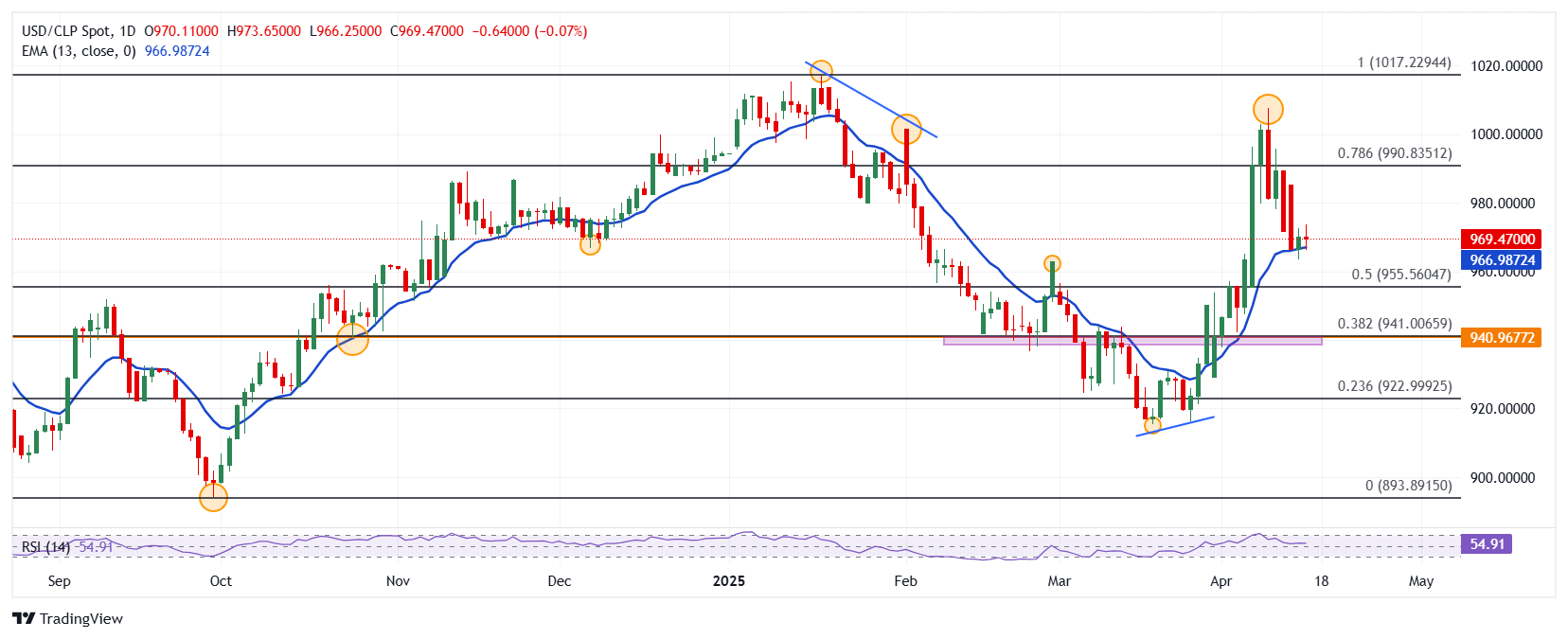- The US dollar falls against Chilean peso, currently operating over 969.25.
- The dollar index (DXY) loses 0.69% today, reaching minimum of April 14 at 99.35.
- The copper misgathers 1.07% today, consolidating within Tuesday’s operational range at $ 4,6404 per pound.
- The United States retail sales increase 1.4% in March, slightly exceeding market estimates.
- The operators will be attentive today to the statements of the president of the Federal Reserve, Jerome Powell.
The USD/CLP established a daily maximum in 973.65, where it attracted aggressive vendors that dragged parity to a minimum of the day in 966.25. Currently, the USD/CLP quotes at 969.25, losing 0.09% in the day.
The Chilean weight operates with profits waiting for the statements of the president of the Federal Reserve
The United States retail sales presented an increase of 1.4% in March, above 1.3% expected and 0.2% registered in February. On the other hand, industrial production decreased 0.3% in the same period, worsening the forecasts of a 0.2% decrease. This figure is after the growth of 0.8% observed in February.
The dollar index falls 0.67% on Wednesday, reaching minimum of April 14 by 99.35, consolidating below the key level of 100.00.
The price of copper wins 1.07% today, visiting two -day maximums in 4,6404 $ per pound, resuming the upward perspective amid the commercial negotiations between the United States and China.
The attention of investors will focus the discourse Jerome Powell, president of the Federal Reserve. It is expected to provide clarity in the rhythms of interest rates considering the tariff uncertainty and recent economic data.
The Chilean weight bounces from a minimum of April 14, quoting on positive terrain, while the USD/CLP falls 0.09% daily, currently quoting at 969.25, consolidating within the operational range of the previous session.
Technical levels in the USD/CLP
The USD/CLP reacted down from a short -term resistance given by the maximum of April 9 in 1,007.73. The next key resistance is at 1,017.05, maximum of January 17. Down, the key support zone is 915.57, a pivot point on March 19.
USD/CLP daily graphics

US dollar FAQS
The US dollar (USD) is the official currency of the United States of America, and the “de facto” currency of a significant number of other countries where it is in circulation along with local tickets. According to data from 2022, it is the most negotiated currency in the world, with more than 88% of all global currency change operations, which is equivalent to an average of 6.6 billion dollars in daily transactions. After World War II, the USD took over the pound sterling as a world reserve currency.
The most important individual factor that influences the value of the US dollar is monetary policy, which is determined by the Federal Reserve (FED). The Fed has two mandates: to achieve price stability (control inflation) and promote full employment. Its main tool to achieve these two objectives is to adjust interest rates. When prices rise too quickly and inflation exceeds the 2% objective set by the Fed, it rises the types, which favors the price of the dollar. When inflation falls below 2% or the unemployment rate is too high, the Fed can lower interest rates, which weighs on the dollar.
In extreme situations, the Federal Reserve can also print more dollars and promulgate quantitative flexibility (QE). The QE is the process by which the Fed substantially increases the flow of credit in a stuck financial system. It is an unconventional policy measure that is used when the credit has been exhausted because banks do not lend each other (for fear of the default of the counterparts). It is the last resort when it is unlikely that a simple decrease in interest rates will achieve the necessary result. It was the weapon chosen by the Fed to combat the contraction of the credit that occurred during the great financial crisis of 2008. It is that the Fed prints more dollars and uses them to buy bonds of the US government, mainly of financial institutions. Which usually leads to a weakening of the US dollar.
The quantitative hardening (QT) is the reverse process for which the Federal Reserve stops buying bonds from financial institutions and does not reinvote the capital of the wallet values that overcome in new purchases. It is usually positive for the US dollar.
Source: Fx Street
I am Joshua Winder, a senior-level journalist and editor at World Stock Market. I specialize in covering news related to the stock market and economic trends. With more than 8 years of experience in this field, I have become an expert in financial reporting.


![News and prognosis of the price of the pound sterling: GBP/USD shoots above 1,3400 [Video] News and prognosis of the price of the pound sterling: GBP/USD shoots above 1,3400 [Video]](https://editorial.fxsstatic.com/images/i/GBPUSD_Large.png)




